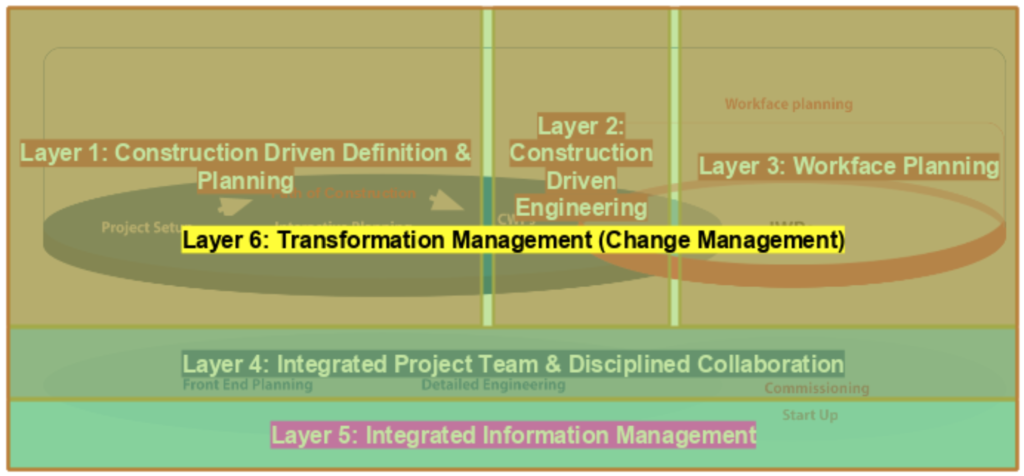This powerful process can help your organization succeed with Advance Work Packaging, writes Olfa Hamdi
Some capital project organizations approach the implementation of Advanced Work Packaging as if they’re simply adding another tool to their corporate toolbox: an open and shut case. I prefer to think of the AWP implementation like an organ transplant: lengthy and complex, with a serious risk of rejection. In this article, I’ll talk about how Concord®’s AWP implementation layers can help leaders predict, plan for and overcome the challenges that come with major organizational surgery such as implementing AWP. Let’s dive in.
Whether you’re building a capital project team from the ground up or implementing AWP in an existing project environment, you’re never truly starting from scratch. You’re always introducing AWP to people, and people come with training, expertise, experience — and strong beliefs about the right way to do things. The implementation of Advanced Work Packaging will require that your people change parts of how they do their work. Change is hard, and often resisted. Implementation layers can help.
It’s worth noting that a maturity assessment is a prerequisite for everything that follows. Leaders always need a comprehensive understanding of the strengths and weaknesses in their project delivery systems before they embark on an AWP implementation. This includes an assessment of project management and controls, engineering, procurement, contracts, and collaboration protocols, among other things. AWP will impact every aspect of your project delivery system, and you need to know where you’re standing before you start.
Whether you’re building a capital project team from the ground up or implementing AWP in an existing project environment, you’re never truly starting from scratch.
Olfa Hamdi Tweet
Now, on to implementation layers. For many years, the concept of implementation layers was a proprietary methodology that we used only for Concord® clients. I’d write about the importance of approaching capital projects with a predictability mindset, but I never elaborated on how we achieved this for clients, practically speaking. As our organization has expanded to include the Concord® Academy, I’ve been thinking a lot more about our mission, which is to empower and educate capital project professionals. Implementation layers really are the very best way to integrate Predictability Thinking™ into the AWP implementation process, we have decided it’s time to share this with the industry as a whole.
What Is An Implementation Layer?
Implementation layers are to your AWP implementation what the front-end definition phase is to your capital project. An implementation layer is a scope of application that defines when, where and why you plan to apply AWP in your organization. We’ve identified six layers of AWP implementation, which can be applied individually, all at once, or in a specific combination.
LAYER 1 — Adopt Construction-Driven Definition and Planning
In Layer One, the organization is focused on creating construction-driven processes for the planning phases of the project. This includes construction-driven phasing, plans and schedules. This layer is generally first adopted by the Owner organization, and/or the FEED contractor.
LAYER 2 — Embrace Construction-Driven Engineering
In Layer Two, the engineering team modifies its workflow so that engineering work packages are defined and executed to support the construction sequence. This can happen as a standalone transformation, or in connection with Layer One. Note that the change here must be led and embraced by the engineering groups.
AWP will impact every aspect of your project delivery system, and you need to know where you’re standing before you start
Olfa Hamdi Tweet
LAYER 3 — Improve Field Planning to Maximize On-Tool Time
In rare cases, Layer Three — also known as Workface Planning — can be a stand-alone process for subcontractors and construction management teams. It’s important to understand, however, that the “garbage in, garbage out” rule always applies to Workface Planning. If Layers One and Two aren’t in place, and the information supplied to the field teams is not construction-driven, then you won’t see the results in your Workface Planning.
LAYER 4 — Establish Disciplined Collaboration
Advanced Work Packaging impacts everybody in your organization: their roles, their daily work, their interactions with each other, and their outcomes. It is imperative that leaders establish a structure and systems that support disciplined collaboration. This is a separate effort because it takes as much effort as any of the first three technical layers, and it is often overlooked entirely.
LAYER 5 — Integrated Information Management
The way that information flows through your organization is dictated largely (though not entirely) by the process decisions you make in the first four layers. This is why we only tackle knowledge management and technology systems after the first four layers have been addressed. Companies that implement AWP technology as a standalone layer with no consideration to the first four layers almost always compound the difficulties they face in AWP implementation.
LAYER 6 — Transformation Management
Layer Six is the step that is most often ignored by capital project organizations, and the layer that almost always delivers true market differentiation. Organizations that fail to manage change often fail to reap the benefits of AWP, even if they do everything else right. Successful organizations budget for, plan and execute a comprehensive change management program.

There you have it — Concord®’s six implementation layers, short and simple. Are any of these applicable to your organization? Where are your strengths? Your weaknesses? What can you do to improve today? If you’re interested in learning more about our implementation layers, be sure to subscribe to Velocity® and get the complete series delivered directly to your mailbox over the coming months, along with other great insights and ideas for more predictable capital projects.
If you’d like to move faster, schedule a free consultation today.





